Flower enthusiasts in North Carolina don’t have to look far to find an incredible display. It’s tulip time in the Tar Heel State come spring! Check out one of the farms in your area for a you-pick bouquet, or better yet, plant your own. We’ll discuss five tulips that grow beautifully in North Carolina, including how to plant them, when they bloom and more!
Types of Tulips
There is a vast array of tulip varieties available today in almost every hue imaginable and an assortment of different forms. These have all derived from the tulips that grew as wildflowers along the mountainsides of central Asia. Species, or Botanical tulips, have retained the characteristics of these early tulips and remain unhybridized. These are often grown as perennials. All other groups, such as the Darwin-hybrid and the Triumph tulips have been hybridized and do best when planted as annuals.
Tulips to Grow in North Carolina
Gardeners in North Carolina should know what USDA planting zone their region falls within. These planting zones are based on the average annual minimum winter temperatures of a given location and are divided into 10-degree Fahrenheit zones and 5-degree half-zones. Consult the map for North Carolina to determine your planting zone.
North Carolina has small regions that fall under zone 5b, the rest of the state is within zones 6a to 8b. While some tulips will do well in warmer zone 8 climates, most tulips are rated for planting zones 3-7. They prefer moist winters and warm, dry summers. Tulips can grow beautifully in all regions of North Carolina, but may require some special care to thrive in the warmest zones where winters are more mild.
1. Lady Tulip
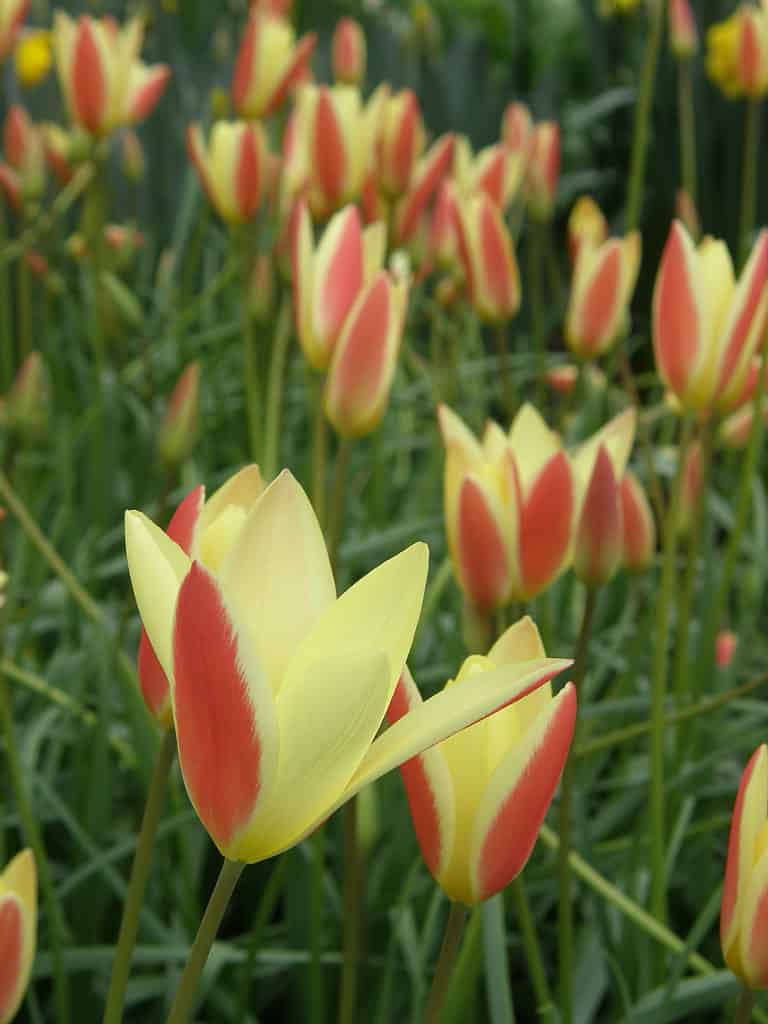
Lady tulips grow beautifully as perennials in North Carolina gardens.
©Sergey V Kalyakin/Shutterstock.com
Also known as Clusius’s Tulip, Lady Tulip (Tulipa clusiana) is an early spring perennial. These tulips have bright green foliage and tender stems that lead up to dainty vase-like white blooms with pink or red edges. Their tepals taper out to delicately pointed tips, and these blossoms close in cloudy weather and at night. When closed, the blossom is bowl-shaped, but on sunny days they extend out into a star-shape. They reach 9 to 12 inches tall. This Species Group tulip naturalizes well in the garden and will produce larger colonies in time. They do well in rock gardens and containers and are an excellent choice for a graceful planting that will bless your garden bed with blooms year after year.
2. Tulip Black Hero
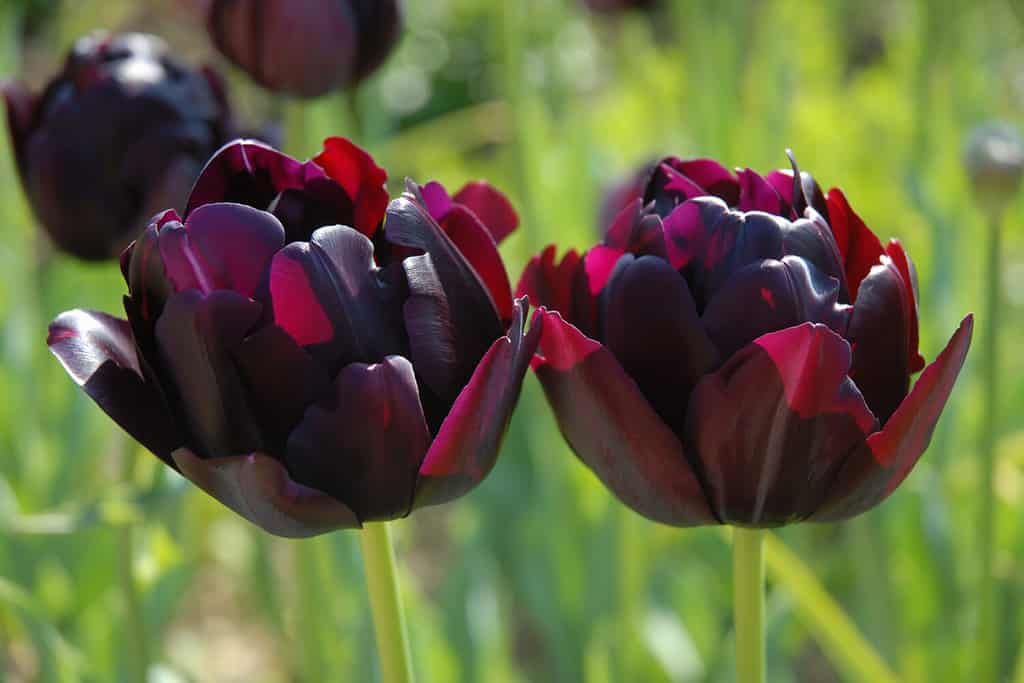
Black Hero tulips are dramatically dark, peony-shaped masterpieces in bloom.
©Josie Elias/Shutterstock.com
If you’re looking for a dramatic variety to darken things up, Black Hero is sure to add some contrast to a bright spring garden. A member of the Double-late Group, also known as Peony Flowering Tulips, this variety erupts with impressive double blooms of purple to midnight-black in mid to late spring. This is a double-flowing version of the ‘Queen of Night,’ known as the darkest tulip in the trade. If winter temperatures are insufficiently cold or fluctuate too much, it could result in a single-flowered blooming. They grow to an average height of 22 inches.
3. Tulip Menton
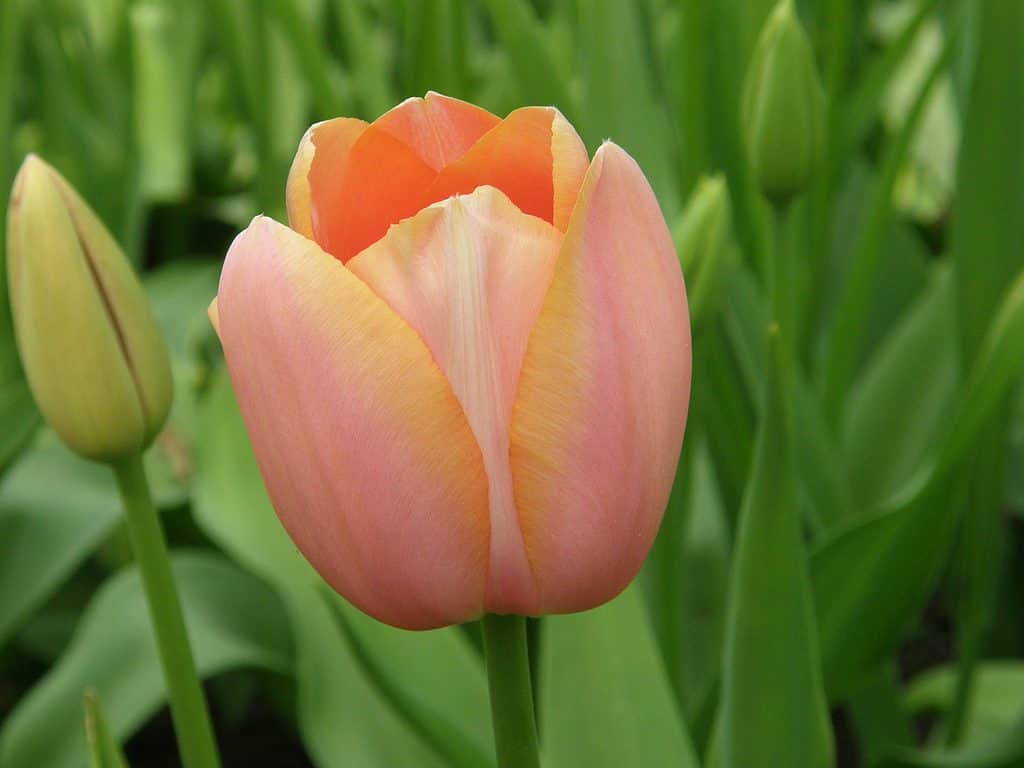
Apricot-pink Single Late Menton tulips showcase the classic egg-shaped tulip blossom.
©Sergey V Kalyakin/Shutterstock.com
A Single Late variety, Menton features elegant, egg-shaped blossoms that are rosy-apricot in hue. This is a sturdy late-spring bloomer that can stand up to bouts of wind and rain. They grow 24 to 26 inches tall and are romantic additions to any bouquet. Planted alongside other varieties or shining all on their own, they are a perfect addition to any North Carolina garden.
4. Tulip Maureen
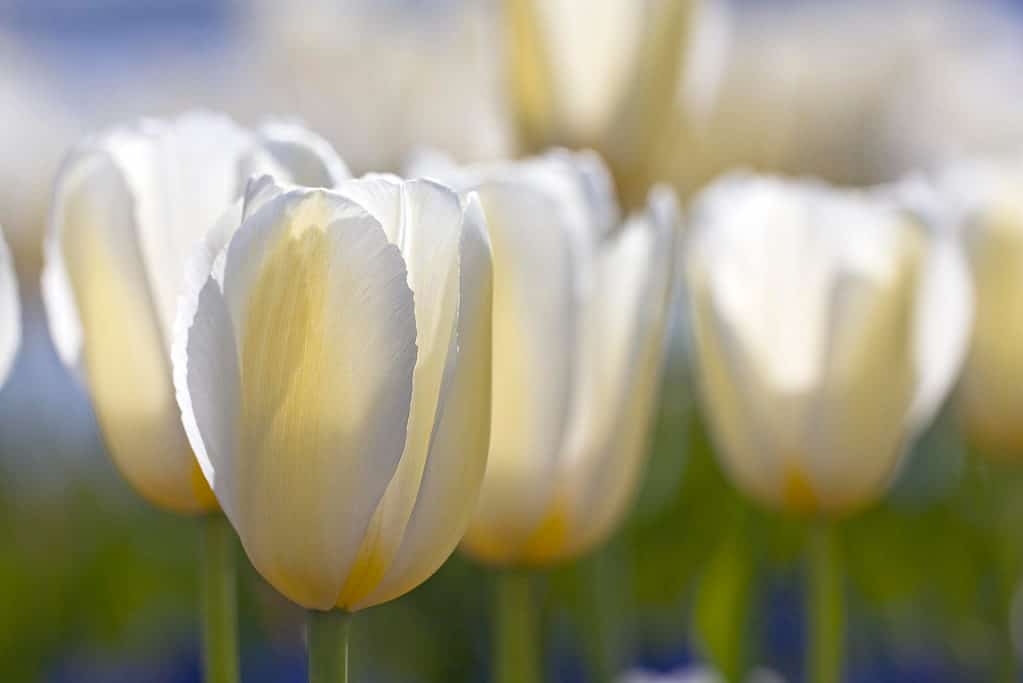
Maureen Single Late Tulips are radiant in the springtime sunshine.
©imageBROKER.com/Shutterstock.com
Another Single Late variety, Maureen blooms with the classic, chalice shaped tulip flowers that begin with a pale yellow hue and mature to a stunning marble-white. Their timing makes for a perfect accompaniment to Menton in the garden. These robust tulips grow on tall stems that reach up to 28 inches. They make excellent cut flowers and are a bright addition to any landscape. Maureen is a variety of French Single Late Tulips, also known as Scheepers Hybrids, which are known to be more perennial than other Single Lates. Since their bulbs mature earlier they may also perform better in warmer climates.
5. Tulipa orphanidea ‘Flava’
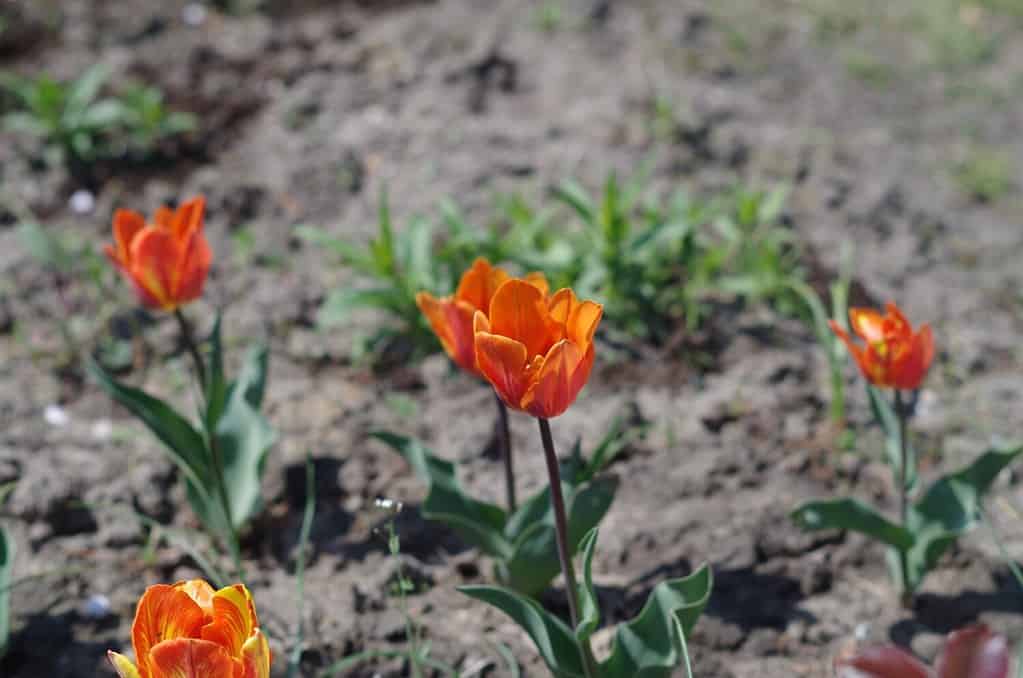
Tulipa
orphanideaare not only beautiful, but beneficial for the local pollinators.
©shadesofquartz/Shutterstock.com
Another Botanical, or Species variety, this perennial tulip is a mid to late season bloomer. A cluster of these small tulips gives the impression of small golden crowns springing forth from the landscape. Their bronze yellow petals spout orange outer flares and are often tipped with red. These tulips grow an average of 7 to 9 inches tall. Rock and woodland gardens shine with plantings of this variety and the pollinators love them!
When to Plant Tulips in North Carolina
Sometime during the summer you’ll want to make your final decisions about which tulips you’d like to see come up in your garden the following spring. Find out what your local nursery has in stock or browse bulb catalogs and get your orders in. Plant your bulbs 6-8 weeks before it is predicted to freeze in your area. Tulips will thrive when planted in soils that have reached 40-50 degrees F. For zone 5b regions, planting time will likely be in September. In zones 6-7, you’ll probably be planting in October and zone 8 plantings will happen a bit later, in November or December.
How to Plant and Care for Tulips in North Carolina
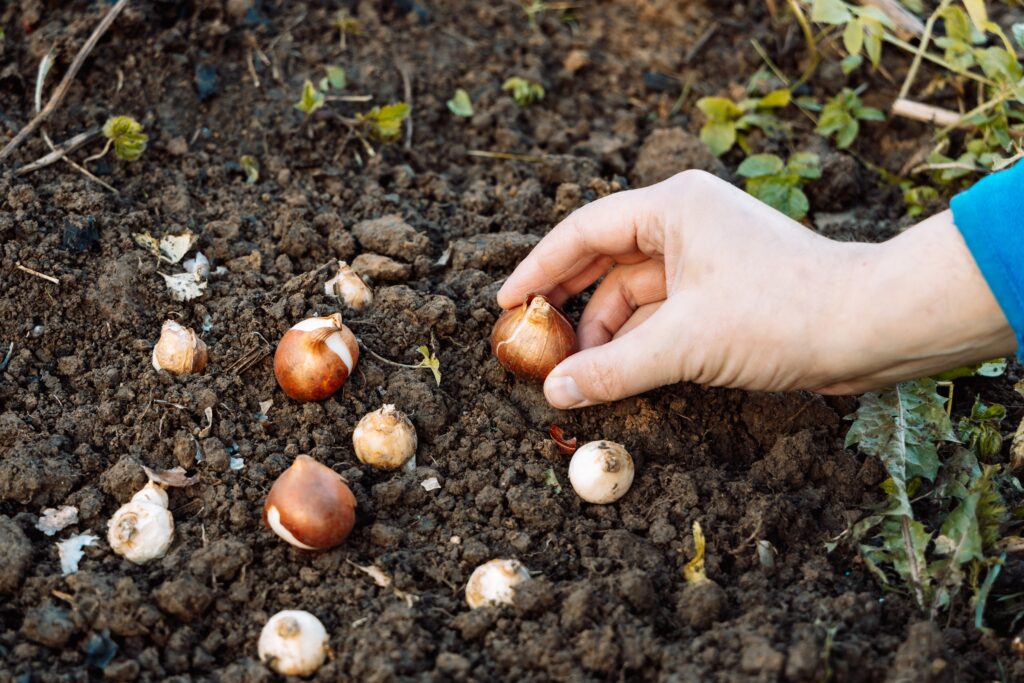
Tulips look best when planted in clusters rather than strict rows.
©S.O.E/Shutterstock.com
Tulips love sunny areas and need well-draining soil to reach their full potential. They require fertile soils of chalk, loam and sand. Research necessary amendments to improve drainage if your soil is very clay-like to avoid potential problems with rot.
You will want to plant your bulbs 2-3 times as deep as they are tall. They look great in clusters, so don’t worry about planting in uniform rows. Give roughly 3-8 inches of spacing between them, depending on bulb size and the visual you’d like to achieve. Make sure to place the pointed end up when planting.
Add a mulch layer to protect the bulbs and retain moisture. After giving the bulbs your attention when choosing varieties and getting them safely in the ground, these beauties are mostly hands-off! Simply water once thoroughly at planting time and leave them be. If a long drought comes along in your area you may want to give them a watering to help things along.
Potential Plant Problems
You may notice aphids, slugs and snails, but they aren’t a problem unless they get out of hand. Gray squirrels, voles, mice and deer are often attracted to tulips and may eat the bulbs or nibble on the plants. Potential diseases include tulip fire, tulip gray bulb rot and others. Improperly stored bulbs can develop blue mold and poorly drained soils can result in root or bulb rot.
When do Tulips Bloom?
The timing of tulip blooms depends mostly on the variety that you choose to plant. While all tulip varieties bloom in the springtime, there are early, mid and late season bloomers. Your planting region, weather conditions and other factors may come into play but generally you can expect the varieties you choose to predictably bloom at a specific time. Lady Tulips bloom early, typically in March. Black Hero is a mid-late season bloomer, most often appearing during late April. Maureen and Menton are both late-season, May-flowering varieties. Triumphs are another tulip group that can grow well in North Carolina and bloom mid-season, while Viridiflora tulips are a late blooming group.
You can plan on a balanced mix of early, mid and late season varieties to promote a long-lasting spring tulip display. For the tulips you’re treating as annuals, you’ll want to dig them up after their blooms are spent. For perennials, you’ll clip wilted flower heads and let the foliage continue to grow. Once fully yellow and wilted, you’ll want to cut the foliage back as well.
Where to View Tulip Gardens in North Carolina
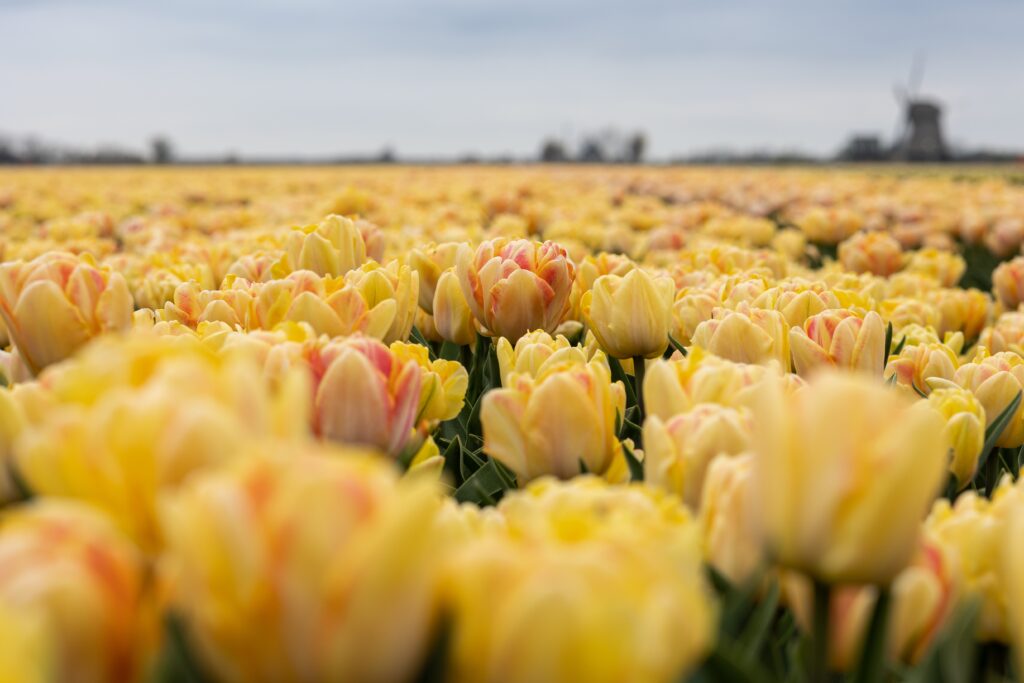
Find a you-pick farm or simply take a stroll in one of the tulip fields of North Carolina.
©dariapine /Shutterstock.com
If you just can’t get enough tulips this spring, be sure to check out one of the many farms around North Carolina offering a stroll through the bounty of blooms:
Dewberry Farm in Kernersville, North Carolina sits on 20 acres of a historic 100-acre family farm. It’s a private residence that is only open to the public for reserved weddings and during the special occasions of summertime sunflowers and springtime tulips! They plant around 100,000 tulips to be enjoyed during scheduled time slots as a ticketed event. During the event you can pick your own flowers, take photographs and explore the farm and venue.
If you find yourself near Hillsborough come springtime, be sure to check out Eno River Tulip Fields. They offer you-pick tulips and usually have strawberry picking during tulip time as well. Make sure to give their homemade ice cream a try while you’re there, made daily with fresh picked berries!
The Biltmore Garden in Asheville hosts a delightful tulip garden. Stroll along the extravagant tulips plantings and check out the rest of grounds of the largest private estate in the United States.
Howard Farms in Harmony allow you to pick your own bouquet and has an incredible selection of tulips come springtime. Just be sure to call ahead of your visit to verify the hours they’ll be open as they are subject to change.
The photo featured at the top of this post is © blue caterpillar/Shutterstock.com
Thank you for reading! Have some feedback for us? Contact the AZ Animals editorial team.







